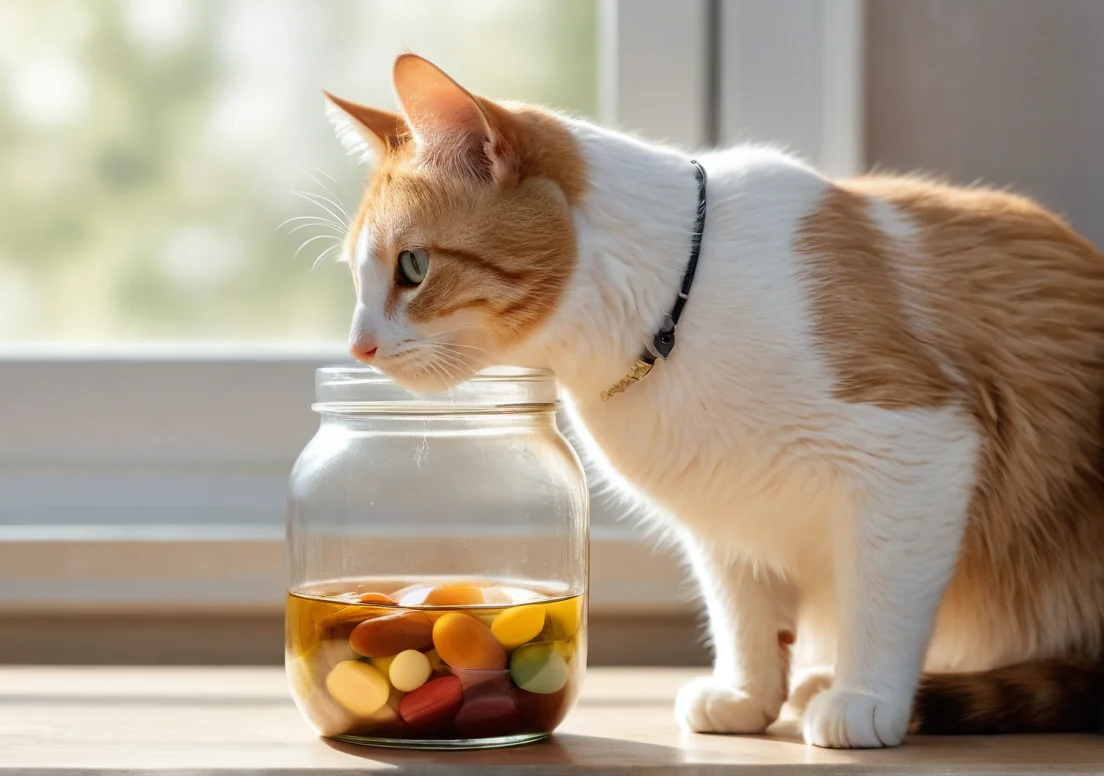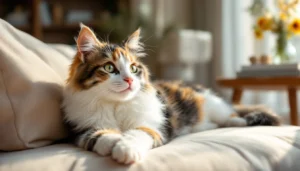Cats have a knack for surprising behaviors, and opening jars is one of the quirkiest. It might sound like a trick from a magician’s hat, but many cat owners have found their furry friends pawing at those tightly sealed containers.
So, why does a cat open a jar? It’s primarily driven by curiosity and a playful nature. Cats are naturally inquisitive creatures that enjoy exploring their environment and discovering new textures, sounds, and smells. But there’s a fascinating layer to this behavior that goes beyond mere playfulness; read on to uncover the intriguing secrets behind your cat’s jar-opening exploits.

What motivates a cat to investigate jars
Cats are naturally curious creatures, always on the lookout for anything that piques their interest. Jars, with their shiny surfaces and intriguing contents, catch their attention for several reasons.
Firstly, cats are instinctively drawn to novelty. A new jar in their space signals something different from their usual surroundings, and instinct pushes them to check it out. The sight and sound of the jar moving or items shifting inside can trigger their hunting instincts.
Additionally, the smell factor can’t be overlooked. If a tasty treat is hidden inside, cats will sniff it out, driven by the desire to explore scents that captivate them. The jar’s shape and construction also add to the appeal—its hard surface can be an exciting challenge, making it a perfect object for playful exploration.
Another angle is the entertainment value. Cats often play with items that are visually interesting or that they can manipulate. Opening jars may feel like a game to them, as engaging with their environment boosts their mood and provides necessary mental stimulation.
Do cats use their paws strategically?
Cats have a unique approach to using their paws, often exhibiting deliberate and strategic actions while interacting with objects like jars. Their dexterous and sensitive paws allow them to perform movements that look purposeful.
For example, many cats have been observed to tap or swipe at the tops of jars, using their claws to grip and manipulate the surface. This behavior isn’t just random; it reflects their understanding of cause and effect. When they push the lid of a jar, they might be testing if it will move or open.
Here’s a closer look at how cats might tactically engage with jars:
- Balance: They’ll often paw at a jar to see if it tips over, which can be an exciting challenge.
- Pressure: Cats understand how much force to apply; too little and nothing happens, too much and they risk losing their grip.
- Curiosity-Induced Persistence: If a jar remains sealed, they might experiment with different paw movements, showing their determination to uncover whatever’s inside.
An interesting observation is that some cats develop a specific technique for opening jars, showing a learned behavior rather than just instinctual action. They might adopt a claw-and-pull method, which demonstrates their adaptability and intelligence. This shows how keenly aware they are of their surroundings and how willing they are to engage with them. It’s not merely about curiosity; it’s intellectual play at its best.
Is there a scent that attracts cats?
Certain scents absolutely captivate cats, and jars can often hold intriguing aromas that draw them in. For instance, jars containing strong-smelling foods or treats can trigger your cat’s curiosity. Cats have an extraordinary sense of smell—about 14 times better than ours—which means even subtle odors can pique their interest.
When a cat encounters a jar, it’s likely sniffing out something appealing. Herbs like catnip are particularly enticing; if you’ve stashed some away, your feline friend might be determined to investigate and possibly open the jar. Additionally, scents of fish or poultry can turn an ordinary jar into an irresistible puzzle for your kitty.
The allure of these scents can lead to playful behavior, particularly when they interact with the jar in their quest for those delicious smells. So, that jar of treats isn’t just a container; to your cat, it’s a treasure trove filled with potential delight.
How does playtime factor into this behavior?
Play is a huge part of a cat’s life, and they often incorporate it into everything they do, including interacting with jars. Cats are natural explorers and intrinsically motivated to engage with their environment. When they see a jar, it isn’t just about seeking food; it’s also an opportunity to play.
Engagement with objects like jars can mimic hunting behaviors. For instance, your cat might paw at, nudge, or even try to dig inside the jar. This can provide them hours of entertainment, fulfilling both their playful and inquisitive instincts.
Consider these factors related to playtime and jar interactions:
- Curiosity: Cats are naturally curious about their surroundings. A jar offers new textures, shapes, and the potential for sound.
- Physical Activity: Interacting with a jar can stimulate their reflexes and keep them active.
- Mental Stimulation: Figures out how to open a jar keeps their minds engaged.
To enhance this behavior in a safe way, provide your cat with interactive toys or even jars filled with safe items they can bat around. Just make sure that whatever’s inside is secure and non-toxic, ensuring their playtime stays fun and safe.
Are some breeds more likely to open jars?
Certain cat breeds have unique traits that may make them more adept at opening jars. Breeds like the Maine Coon, Bengal, and Siamese are often noted for their high energy and curiosity. These cats tend to be more adventurous and interact actively with their surroundings, which can lend itself to creative problem-solving.
Maine Coons, for example, are not only large but also incredibly intelligent. Their playful nature can lead them to figure out how to manipulate objects, such as twisting off jar lids. Bengals, with their playful, exploratory behavior, may see a jar as an intriguing puzzle to solve. Meanwhile, Siamese cats are often more social and tend to be quick learners, making them potential jar-opening prodigies.
Other breeds, like Russian Blues and Scottish Folds, may not be as naturally inclined toward jar-opening antics, but their intelligence can still lead to unexpected feats if motivated by treats or toys.
Quick insight : Regardless of breed, any cat can be influenced by positive reinforcement. If a cat associates jar opening with rewards, it might just pick up the skill, regardless of its genetics!
What role does intelligence play in this behavior?
The cognitive abilities of cats heavily influence their behavior, including the curious act of opening jars. Cats have a unique way of processing the information around them and can exhibit problem-solving skills that rival many small mammals.
A cat’s intelligence isn’t just about a high IQ; it’s about how they interact with their environment. Kittens, for instance, learn through play and exploration. Adult cats use that knowledge to figure out challenges. When faced with a jar, they observe the mechanics—turning, pushing, and pawing at it until something works. It’s a blend of instinct and learned behavior.
Moreover, environmental factors play a significant role. Cats raised in stimulating environments, rich with toys and puzzles, tend to develop better problem-solving skills. If they see their owners opening jars or manipulating objects, they start to connect the dots themselves.
In practical terms, here are some key benefits of a cat’s intelligence in this behavior:
- Exploratory Nature: Intelligent cats are more likely to explore and experiment with opening jars.
- Learned Problem-Solving: They can observe and mimic how humans interact with objects.
- Curiosity-Driven: Cats that are encouraged to engage with their environment are more prone to tackle new challenges.
Having a lot of interaction and stimulation can make it more likely that your cat will engage in jar-opening antics. Keep those brains active, and who knows what your feline might achieve next?
Can opening jars be harmful?
Cats are notoriously curious creatures, and their attempts to open jars can lead to unexpected, and sometimes hazardous, situations. While you might find it amusing to watch your furry friend pawing at a jar, there are real risks involved.
One major concern is injury. If a cat is determined enough, it might use its teeth or claws excessively, leading to cuts or scratches. Additionally, if the jar breaks, it could result in sharp shards that can cause serious harm. Even less severe injuries can lead to infection or a need for veterinary attention.
Another pressing issue is the possibility of consumption of harmful substances. If the jar contains food, you may have leftovers that aren’t safe for your cat. Certain human foods, like chocolate or garlic, can be dangerous. A cat that successfully opens a jar could munch on these, leading to poisoning or gastrointestinal distress.
It’s wise to keep jars and similar containers out of reach. Preventing access is the simplest way to keep your curious feline safe.
What are some fun alternatives to jars for cats?
Instead of letting your cat indulge its curiosity by opening jars, consider offering more suitable options. Here are some safer alternatives to keep those playful paws busy:
- Puzzle feeders: These can stimulate your cat mentally while providing treats or kibble—a two-for-one delight!
- Interactive toys: Toys that dispense treats when played with can satisfy your cat’s inherent hunting instincts.
- Cardboard boxes: Simple yet effective, boxes provide endless fun for exploring and scratching.
- Cat tunnels: Tunnels create a fantastic hide-and-seek adventure that your cat will love.
- String and feather toys: These can engage your cat in active play, mimicking the thrill of a hunt.
With these alternatives, you’re not only ensuring safety but also providing joy and engagement for your pet. A little novelty goes a long way in keeping your cat entertained!
How can you train your cat to open jars safely?
Training your cat to open jars can be a playful way to engage their natural curiosity and dexterity. Cats are crafty little creatures, but safety should always be your top priority. Here’s a friendly guide to help your feline friend learn this fun trick while ensuring they don’t accidentally hurt themselves.
Start by choosing a sturdy jar with a relatively easy-to-open lid. Glass jars can be slippery, so consider using plastic ones to make it less hazardous. Make sure the jar is free of sharp edges, and avoid lids that can easily snap off.
1. Introduce the jar : Place the jar on a flat surface where your cat often plays. Encourage them to explore it by sprinkling a few of their favorite treats around it. This creates a positive association with the jar.
2. Use treats : Once your cat is comfortable with the jar, reward them every time they interact with it. If they paw at it or sniff it, offer a treat. Gradually, you can place a treat inside the jar, making the reward even more enticing.
3. Engage their paws : Gently tap the lid while your cat is nearby, enticing them to try and open it themselves. Reward their attempts, even if they don’t get it right at first. Positive reinforcement is key!
4. Model the action : If you’re comfortable, show them how you open the jar. Even though they won’t mimic you exactly, they might understand the concept better when they see you doing it.
5. Keep sessions brief : Cats have short attention spans, so limits on each training session to five to ten minutes will keep it fun and stress-free.
As a unique tip, consider clicker training. This method can be very effective. Each time your cat interacts with the jar, use a clicker and follow it up with a treat. This reinforces the behavior and clarifies exactly what action you’re rewarding.
Combining these strategies can turn jar-opening into an enjoyable bonding activity, giving your cat a task that’s not just safe but mentally stimulating too.
Alex, a passionate animal lover, has experience in training and understanding animal behavior. As a proud pet parent to two dogs and three cats, he founded AnimalReport.net to share insights from animal experts and expand his knowledge of the animal kingdom.




